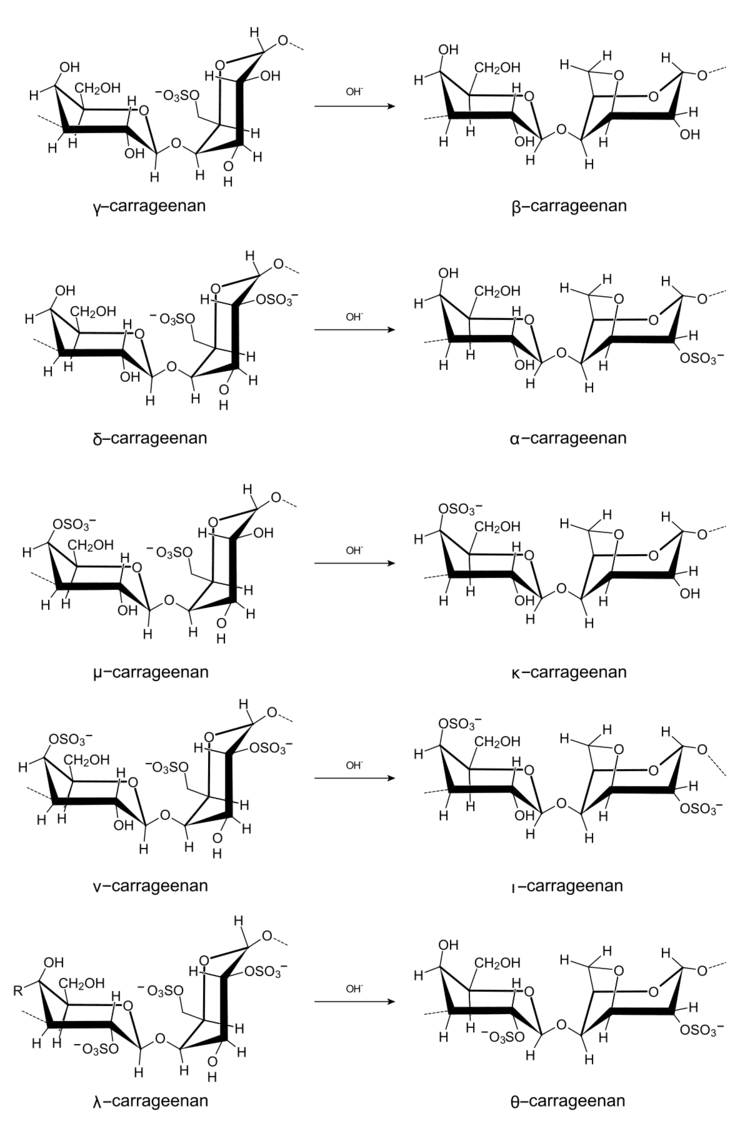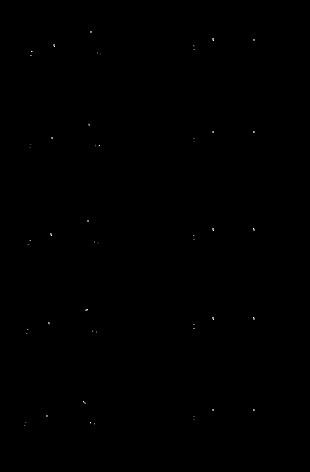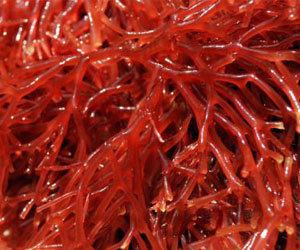Classification Polysaccharide | ||
 | ||
Carrageenans or carrageenins (/ˌkærəˈɡiːnənz/ KARR-ə-GHEE-nənz from Irish carraigín, "little rock") are a family of linear sulphated polysaccharides that are extracted from red edible seaweeds. They are widely used in the food industry, for their gelling, thickening, and stabilizing properties. Their main application is in dairy and meat products, due to their strong binding to food proteins. There are three main varieties of carrageenan, which differ in their degree of sulphation. Kappa-carrageenan has one sulphate group per disaccharide, Iota-carrageenan has two, and Lambda-carrageenan has three.
Contents
- Carrageenan the basics of food gums
- Properties
- Production
- Semi refined
- Refined
- Mixed processing
- Grades
- Food and other domestic uses
- Regulatory status
- Controversy
- Animal studies
- References

Gelatinous extracts of the Chondrus crispus (Irish Moss) seaweed have been used as food additives since approximately the fifteenth century. Carrageenan is a vegetarian and vegan alternative to gelatin in some applications or may be used to replace gelatin in confectionery.
Carrageenan the basics of food gums
Properties

Carrageenans are large, highly flexible molecules that curl forming helical structures. This gives them the ability to form a variety of different gels at room temperature. They are widely used in the food and other industries as thickening and stabilizing agents.

All carrageenans are high-molecular-weight polysaccharides made up of repeating galactose units and 3,6 anhydrogalactose (3,6-AG), both sulfated and nonsulfated. The units are joined by alternating α-1,3 and β-1,4 glycosidic linkages.
There are three main commercial classes of carrageenan:


The primary differences that influence the properties of kappa, iota, and lambda carrageenan are the number and position of the ester sulfate groups on the repeating galactose units. Higher levels of ester sulfate lower the solubility temperature of the carrageenan and produce lower strength gels, or contribute to gel inhibition (lambda carrageenan).
Many red algal species produce different types of carrageenans during their developmental history. For instance, the genus Gigartina produces mainly kappa carrageenans during its gametophytic stage, and lambda carrageenans during its sporophytic stage.
All are soluble in hot water, but in cold water, only the lambda form (and the sodium salts of the other two) are soluble.
When used in food products, carrageenan has the EU additive E-number E407 or E407a when present as "processed eucheuma seaweed". Technically carrageenan is considered a dietary fibre.
In parts of Scotland and Ireland, where it is known by a variety of local and native names, Chondrus crispus is boiled in milk and strained, before sugar and other flavourings such as vanilla, cinnamon, brandy, or whisky are added. The end-product is a kind of jelly similar to pannacotta, tapioca, or blancmange.
Production
Although carrageenans were introduced on an industrial scale in the 1930s, they were first used in China around 600 B.C. (where Gigartina was used) and in Ireland around 400 A.D. Carrageen gelatin can be prepared at home using the traditional recipe found in Diderot's Encyclopédie and used for centuries. 5oz rinsed Irish moss is cooked with 8 quarts of water for 10 minutes, stirred as it boils. Hard water should be mixed with 1/2 oz of borax. Two quarts of cold water are rapidly added to the hot brew, and after the mixture has cooled it is strained through a cloth. It is then cooled for 24 hours and becomes gelatinous.
As of 2011, global sales of carrageenan were estimated at $640 million. The largest producer of industrial carrageenan was the Philippines, where cultivated seaweed produces about 80% of the world supply, while China is the main exporter to global markets in the US and Europe. The most commonly used sources are E. cottonii (Kappaphycus alvarezii, K.striatum) and E. spinosum (Eucheuma denticulatum), which together provide about three-quarters of the world production. These grow from the sea surface to a depth of about 2 metres. The seaweed is normally grown on nylon lines strung between bamboo floats, and it is harvested after three months or so, when each plant weighs approximately 1 kg.
The E. cottonii variety has been reclassified as Kappaphycus cottonii by Maxwell Doty (1988), thereby introducing the genus Kappaphycus, on the basis of the phycocolloids produced (namely kappa carrageenan).
After harvest, the seaweed is dried, baled, and sent to the carrageenan manufacturer. There the seaweed is ground, sifted to remove impurities such as sand, and washed thoroughly. After treatment with hot alkali solution (e.g., 5–8% potassium hydroxide), the cellulose is removed from the carrageenan by centrifugation and filtration. The resulting carrageenan solution is then concentrated by evaporation. It is dried and ground to specification.
There are three types of industrial processing:
Semi-refined
This is only performed using E. cottonii or E. spinosum. The raw weed is first sorted and crude contaminants are removed by hand. The weed is then washed to remove salt and sand, and then cooked in hot alkali to increase the gel strength. The cooked weed is washed, dried, and milled. E. spinosum undergoes a much milder cooking cycle, as it dissolves quite readily. The product is called semi-refined carrageenan, Philippines natural grade or, in the U.S., it simply falls under the common carrageenan specification.
cleaned and washed seaweed ↓ extraction ↓ coarse filtration → seaweed residue ↓ fine filtration → used filter aids ↓ ↓-------------- concentration --------------↓ preparation with KCl preparation with alcohol ↓ ↓ gel pressing alcohol recovery ↓ ↓ drying drying ↓ ↓ milling milling ↓ ↓ blending blending ↓ ↓ gel refined carrageenan refined carrageenanRefined
The essential difference in the refining process is that the carrageenan is first dissolved and filtered to remove cell wall debris. The carrageenan is then precipitated from the clear solution either by isopropanol or by potassium chloride.
Mixed processing
A hybrid technology in which seaweed is treated heterogeneously as in the semirefined process exists, but alcohol or high salt levels are used to inhibit dissolution. This process is often used on South American seaweeds and gives some of the cost benefits of semirefined processing, while allowing a wider range of seaweeds to be processed, however, the naturally low cellulose levels in some South American seaweeds allow them to be heterogeneously processed and still be sold under the EU refined specification.
Grades
There are two basic grades of carrageenan: refined carrageenan (RC) and semi-refined carrageenan (SRC). In the United States both grades are labeled as carrageenan. In the European Union, refined carrageenan is designated by the E number E-407, and semi-refined carrageenan as E-407a. Refined carrageenan has a 2% maximum for acid insoluble material and is produced through an alcohol precipitation process or potassium chloride gel press process. Semi-refined carrageenan contains a much higher level of cellulosic content and is produced in a less complex process. Indonesia, the Philippines, and Chile are three main sources of raw material and extracted carrageenan.
Food and other domestic uses
Regulatory status
In the U.S., carrageenan is allowed under FDA regulations as a direct food additive and is considered safe when used in the amount necessary as an emulsifier, stabilizer, or thickener in foods, except those standardized foods that do not provide for such use. FDA also reviewed carrageenan safety for infant formula. The European Food Safety Authority concluded "there is no evidence of any adverse effects in humans from exposure to food-grade carrageenan, or that exposure to degraded carrageenan from use of food-grade carrageenan is occurring", Furthermore, the Joint FAO/WHO expert committee on food additives stated in a July 2014 review of carrageenan "that the use of carrageenan in infant formula or formula for special medical purposes at concentrations up to 1000 mg/L is not of concern".
Although the National Organic Program (NOP) had added carrageenan to its National List of additives allowed to be included in organic foods in 2003, and reviewed and reauthorized it in 2008, noting it as "critical to organic production and handling operations", on November 18, 2016 the NOP's National Organic Standards Board (NOSB) voted to recommend carrageenan be removed from the National List of additives allowed in organic food production. The NOSB’s recommendation is under review by the United States Department of Agriculture’s Agricultural Marketing Service (AMS). If the AMS accepts the NOSB’s recommendation, a proposed rule to remove carrageenan from organic foods will be published to the Federal Register no later than November 2017.
Controversy
Carrageenan has undergone long-term dietary studies under defined regulatory conditions en route to its current global regulatory status. It has been the subject of many peer-reviewed journal articles and has undergone scrutiny by independent food safety agencies and international review panels. While some indicate that carrageenan safely passes through rat GI tracts without adverse effect when it is a dietary ingredient, other animal dietary studies have disputed its safety.
In the most recent review by an independent panel, the Joint Expert Committee of the Food and Agriculture Organization of the United Nations and World Health Organization on Food Additives (JECFA) released a technical report in 2015 on the use of carrageenan in infant formula and found that the additive was ‘not of concern’ in infant formula as food for special medical purposes at concentrations up to 1000 milligrams per liter.
The use of carrageenan in infant formula, organic or otherwise, is prohibited in the EU for precautionary reasons, but is permitted in other food items.
In the U.S., it was permitted in organic and non-organic foods, including juices, chocolate milk, and organic infant formula until 2016. On November 18, 2016 the National Organic Standards Board voted to remove it from the list of approved substances for food items labeled "organic".
Animal studies
Some animal studies indicate tumor promotion or initiation by carrageenan. In an industry-funded study, Cohen & Ito discuss methodological problems with four such studies, along with several evaluations of genotoxic activity, and state that there is no credible evidence that carrageenan contributes to tumor promotion or colon cancer. In contrast, Tobacman's review of 45 publicly funded studies concludes that "the potential role of carrageenan in the development of gastrointestinal malignancy and inflammatory bowel disease requires careful reconsideration of the advisability of its continued use as a food additive." As of 2011, Kanneganti et al. note that "the role of both CGN [carrageenan] and dCGN [degraded carrageenan] as carcinogens still remains controversial".
Carrageenan's function as a food additive relates to its large molecular weight (200,000–800,000 Da) and tight binding to food protein but also influences carrageenan's fate as it passes through the GI tract. Oral feeding studies with laboratory animals indicate dietary carrageenan is excreted quantitatively and is not accumulated in body organs such as the liver or colon; studies disagree with respect to whether it triggers gastrointestinal tract inflammation or contributes to tumor promotion. Long-term oral feeding studies found no adverse effects on male or female infant baboons reared from birth to 112 days of age on infant formula containing carrageenan at five times the concentration typically present in human infant formula as their only diet but did observe histopathologic changes in rhesus monkey colon after drinking a solution containing 1% undegraded carrageenan. Similarly, while no adverse effects were observed for multi-generations of rats fed up to 5% dietary carrageenan, or on hamsters and rats fed for a lifetime diets containing up to 5% carrageenan, administration of carrageenan to rodents in drinking water has resulted in some observations of GI-tract effects. Tight binding of carrageenan to ingested food proteins is considered less available than in drinking water for interaction with the absorptive cells of the GI tract, although some studies have linked food-grade carrageenan to gastrointestinal disease in laboratory animals, including ulcerative colitis-like disease, intestinal lesions, and ulcerations.
Carrageenan is inert to hydrolysis by intestinal enzymes in both humans and monogastric animals. Many older studies and a few recent studies have been based on the use of "degraded carrageenan", a fraction of low-molecular weight segments of the carrageenan molecular backbone called "poligeenan". To resolve this within the scientific community, the US Adopted Names Council assigned the name "poligeenan" to the fragments with molecular weight of 10,000 to 20,000 Da. Approximately 8% of the fragments of food-grade carrageenan are of molecular mass less than 50,000 Da, in excess of the recommended minimum of 5% set by the European Scientific Committee on Food to ensure that the presence of poligeenan is kept to a minimum. The proportion of this 8% that consists of poligeenan is unknown.
